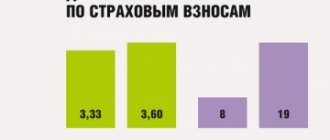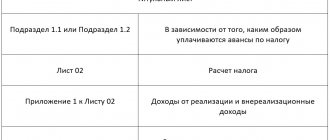What taxes do you have to calculate in Russia?
In any country there are many types of tax deductions. The Tax Code of Russia (TC RF) identifies the following categories of taxes:
- VAT (on value added);
- excise taxes;
- Personal income tax (on the income of individuals);
- on the profit of legal entities;
- for mining;
- water tax;
- fees for the use of biological resources;
- government fees;
- for additional income from hydrocarbon production;
- on the property of legal entities;
- to engage in gambling business;
- for transport;
- to the ground;
- for personal property persons;
- trade fee.
The first nine of them are federal, the next three are regional, and the last three are local. This means that the amount of tax payable will depend on the decision made at the appropriate level, and the funds will go to the appropriate budget.
At the same time, at each level, benefits are adopted for different categories of citizens. Therefore, before calculating the amount of tax, you need to find out whether you have to pay it.
Unified calculation of insurance premiums to the Federal Tax Service
Home / Reporting for employees
Zero settlement on insurance premiums
View a sample zero calculation for insurance premiums
All business entities with at least one employee are required to submit calculations of contributions.
If during the reporting period the entity did not conduct business and did not pay remuneration to individuals, it is necessary to submit a zero calculation.
Form zero should also be submitted to organizations that have only a general director, who is the sole founder.
Individual entrepreneurs who do not have employees do not submit insurance premium payments.
The zero ERSV should include the following form sheets:
- title;
- section 1;
- subsections 1.1. and 1.2 of Appendix 1 to Section 1;
- appendix 2 to section 1;
- section 3 (except for subsection 3.2.).
Penalties for failure to submit forms and calculations with errors
The minimum fine for late submission of the form will be RUB 1,000. for each full or partial month of delay, starting from the last date provided for the payment. But such a fine is possible only if the insurance premiums were transferred to the treasury on time (clause 1 of Article 119 of the Tax Code of the Russian Federation).
If the contributions reflected in the calculation are not received by the budget on time, the sanctions will amount to 5% of the unpaid amount for each month of delay. In this case, the fine should not exceed 30% of this amount, but cannot be less than 1000 rubles.
If part of the insurance premiums was paid on time, then sanctions will be assessed only on the amount of premiums paid after the due date.
Failure to submit a report is not grounds for blocking the policyholder’s bank accounts (letter of the Ministry of Finance of the Russian Federation dated January 12, 2017 No. 03-02-07/1/556).
ERSV will be considered not represented if:
1) For each individual employee the following are incorrectly indicated:
- personal information (full name; INN - if available; SNILS);
- amounts of remuneration and other payments;
- base for calculating contributions to compulsory pension insurance within the limit;
- the amount of contributions to compulsory pension insurance, calculated within the limit;
- base for calculating contributions to compulsory pension insurance for additional tariff;
- the amount of contributions to compulsory pension insurance according to additional tariff.
2) In general, for the organization (IP), the report contains the following errors:
- the amount of accrued contributions (within the limit) is incorrectly indicated both for the entire reporting (calculation) period and for any month (for all the last 3 months) of the period;
- data on the total amount of contributions to compulsory pension insurance do not correspond to the amount of contributions for each individual employee.
In this case, the Federal Tax Service will send a notification to the policyholder, upon receipt of which it is necessary to eliminate the identified inconsistencies.
The corrected calculation should be submitted to the inspectorate:
- within 5 working days from the date of receipt of the electronic notification;
- within 10 working days if the letter from the Federal Tax Service arrived by mail.
Then the date of submission of the ERSV will be considered the date when the calculation was submitted for the first time.
If the policyholder discovers that the submitted calculation contains incorrect information, you must proceed as follows:
| An error led to an underestimation of the amount of payments to the budget | An updated ERSV is submitted, including the corrected sheets, correctly filled out other sheets submitted earlier, and section 3 - only for those persons whose information has been changed. That is, there is no need to submit Section 3 again in full |
| The error did not affect the calculation results | Submission of the adjustment calculation is carried out at the request of the business entity |
Control ratios for calculation of insurance premiums
Verification of the correct completion of reporting indicators is carried out on the basis of a special regulation published by the Federal Tax Service. The control ratios for the calculation of contributions are indicated in the letter of the Federal Tax Service of the Russian Federation dated June 30, 2017 No. BS-4-11/12678. From 01/01/2018, additional control ratios listed in the appendix to the letter of the Federal Tax Service dated 12/29/2017 No. GD-4-11/ [email protected]
The most significant indicators are subject to verification first:
- information about the employees of the business entity - the information presented in the report is verified with the data of the Federal Tax Service;
- final amounts of payments – the amounts of budget revenues are compared with reporting data;
- deadlines for submitting the calculation - the compliance of the date of actual submission of the calculation with the deadline established by the Tax Code of the Russian Federation is checked.
Also, the calculation data is subject to reconciliation with other reporting documentation. According to current rules, information from the ERSV is verified with data from form 6-NDFL.
The main criterion is the comparison of line 030 of subsection 1.1. Annex 1 ERSV (amount of accrued payments to individuals) with line 020 of section 1 in 6-NDFL (total amount of income for all citizens).
In addition, controllers monitor the ratio of current payments and documentation of previous periods - the correctness of the accrual of insurance premiums on an accrual basis is checked.
In total, letters from the Federal Tax Service contain more than 300 control ratios. It is extremely difficult to check all the indicators yourself.
Programs for checking the calculation of insurance premiums
Some specialized accounting websites have launched services to check the correctness of the calculation of contributions and its reconciliation with form 6-NDFL. For example, on the Aktion-MCFER family of sites (some sites require prior registration):
- https://rsv.rnk.ru;
- https://rsv.zarplata-online.ru;
- https://ersv.glavbukh.ru.
You can check the accuracy of the personal data of employees from section 3 of the ERSV directly in your personal account on the Federal Tax Service website. The service “Request for verification of TIN, full name, SNILS of working persons” is presented for taxpayers.
Read in more detail: Example of filling out a single calculation for insurance premiums
Did you like the article? Share on social media networks:
- Related Posts
- 6-NDFL for the 2nd quarter of 2021 (half year)
- Form SZV-M in 2021 - monthly report
- Sample of filling out the SZV-M form
- Financial assistance in 6-NDFL
- 6-NDFL for the 1st quarter of 2021
- Deduction codes in the 2-NDFL certificate in 2021
- Sample of filling out the calculation of insurance premiums
- Sample of filling out the SZV-K form
Discussion: 2 comments
- Hope:
09.28.2018 at 13:34SUPER!!!!!!!!!!
Answer
- Marina:
01/16/2019 at 14:10
Thanks for the prepared material! I prepared reports with your service.
Answer
Leave a comment Cancel reply
Where to get basic data to calculate the tax amount
Art. 17 of the Tax Code of the Russian Federation requires, when introducing a tax, to establish taxation rules. It is necessary to determine:
- taxpayers;
- object of taxation;
- tax base;
- taxable period;
- tax rate;
- calculation order.
These characteristics are indicated in the second part of the Tax Code of the Russian Federation. There is a separate chapter for each tax.
Benefits may also be established by law. Those established at the federal level are indicated in the chapter of the Tax Code of the Russian Federation dedicated to each tax. Regional and local authorities can establish their own benefits. Information on the availability and nature of local and regional benefits can be obtained from the legislative acts of the relevant authorities. The Federal Tax Service (FTS) provides the opportunity to obtain information about the availability of benefits on its website.
Checking the need to calculate the tax amount
Before you start calculating, you need to make sure. that this is necessary. In order for you to need to pay, you need to be a taxpayer and have an object of taxation.
Taxpayers are those individuals or legal entities who are required by law to pay contributions. If you are not listed as a taxpayer for a specific tax, you do not have to pay it and you do not need to calculate anything.
The object of taxation is a circumstance the presence of which causes the need to pay tax. The circumstances may be different: receiving income or profit, engaging in a certain type of business, owning certain property, etc. If you do not have an object of taxation - for example, you have not received income - you do not need to pay tax. Only after making sure that you or your organization are taxpayers does it make sense to start calculating the amount of tax.
How to calculate the tax amount
The procedure for calculating a specific tax is set out in the relevant chapter of the Tax Code of the Russian Federation. In general, the tax base is multiplied by the rate. The result obtained is the tax amount. For example, with personal income tax at a standard rate of 13%, income of 100 thousand rubles is taxed at 13 thousand.
The tax base is a quantitative characteristic of the object of taxation. This could be: amounts of money received as income or profit; units of property, property characteristics (for example, vehicle engine size) and other parameters.
When determining the tax base, an important indicator is the tax period. This is the period for which tax is paid. If, for example, according to personal income tax, the tax period is a calendar year, then all income received in it is included in the tax base.
The tax rate is the amount of tax charged on the tax base. The rate can be expressed as a percentage of income received or as a fixed amount per unit of tax base.
Tax calculation procedure
In order not to make mistakes when calculating, you need to find out the significant indicators of a specific payment. Common elements in calculating tax contributions:
- the tax base;
- bid;
- privileges.
Using a simplified formula, the amount of calculated tax is equal to the tax base multiplied by the tax rate.
A separate chapter of the Tax Code (TC) of the Russian Federation is devoted to each specific contribution. It describes in detail the mechanisms for calculating the tax base, tax rates, the use of benefits and additional coefficients.
The main parameter of the object of taxation is the tax base. Income, profit, value of property or other taxable units may be taken as the basis for calculation. For example:
- when calculating personal income tax, the tax base will be the entire amount of cash receipts for the tax period (salaries, bonuses, other payments);
- If the income tax of an organization is calculated, the base is taken from the amount of income for the year.
- when calculating property tax, the cost or physical characteristics of the taxable object are taken as the base indicator;
- if real estate tax is calculated, its value is taken into account;
- The transport fee per unit of the tax base depends on the main physical parameter of the car - its power.
For different types of tax payments, their own basic indicator is established. The mechanisms for its calculation are provided for by the Tax Code separately for each type of tax. In the tax system of the Russian Federation, the following units of the tax base are used in calculations:
- ruble - to calculate personal income tax and income tax;
- horsepower - in transport;
- hectare, square meter - in land and property taxes.
The tax rate is an indicator that is multiplied by the tax base. Depending on the classification of the taxable object, the rate can be fixed, proportional, progressive or regressive.
Fixed (uniform) tax rates are also called real contributions - they are expressed in a specific number. For example, this is how transport tax rates are calculated. In conditions of inflation, they are periodically revised, increasing or decreasing.
The proportional rate is expressed as a percentage of the tax base. It does not depend on the size of the tax base; its value does not change. These rates apply to:
- income - rate 13%;
- profit of organizations - 20%;
- added value - 0% / 10% / 20%;
- property contribution - from 0.5 to 2% for individuals and no more than 2.2% for organizations.
Progressive/regressive rates depend on the size of the underlying indicator. When it increases, the rate increases or decreases accordingly. In Russia there are no taxes in which these rates are calculated and applied in their pure form. Partially they are included in the transport contribution: when the cost of a vehicle increases or its ownership period increases, an increasing coefficient is applied.
Using benefits when calculating tax amounts
Benefits established by federal, regional or local legislation reduce the amount of tax deductions. This may be a full or partial tax exemption. Other options may apply. For example, when paying personal income tax, the amounts specified in the Tax Code of the Russian Federation are deducted from the tax base before multiplying it by the rate.
Tax benefits allow you to save significantly. Therefore, before you start calculating the tax amount, you definitely need to find out whether you have these benefits.
A quick way to calculate your tax amount
There are many calculators on the Internet for calculating tax amounts. We recommend that you use only calculators from government and well-known reputable sites. We offer you links to several such calculators:
- VAT.
- Penalties for taxes and insurance premiums.
- Personal income tax for tax agents.
- Transport tax.
- Land and property tax.
- Personal income tax.
Any of them will help to make or check the calculation of tax deductions. Online calculators take into account most of the necessary indicators, so the results of their work can be trusted.
Sources:
General conditions for establishing taxes and fees.
Tax calculation procedure.
Tax base and tax rate.
Taxpayers.
Tax burden: calculation formula
So, the size of the fiscal burden is the ratio of the amount of fiscal payments of an economic entity, calculated in percentage terms, to the amount of revenue received, determined according to accounting data for the reporting period.
The indicator must be calculated using the formula:
To correctly calculate such an important indicator, consider the following recommendations:
- Include in the calculation all amounts of fiscal payments that were accrued by the taxpayer in the reporting period.
- Consider the fees the company pays as a tax agent. For example, also include personal income tax for employees in the calculation data.
- Exclude import VAT amounts.
- Do not take into account customs duties payable under current law.
- Also do not include the amounts of accrued insurance premiums in the calculation.
Such recommendations are enshrined in Letters of the Ministry of Finance dated January 11, 2017 No. 03-01-15/208, Federal Tax Service dated March 22, 2013 No. ED-3-3/ [email protected]









